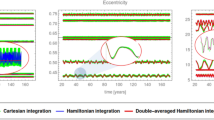Abstract
the paper considers the flyby problem related to large space debris (LSD) objects at low earth orbits. The data on the overall dimensions of known last and upper stages of launch vehicles makes it possible to single out five compact groups of such objects from the NORAD catalog in the 500–2000 km altitude interval. The orbits of objects of each group have approximately the same inclinations. The features of the mutual distribution of the orbital planes of LSD objects in the group are shown in a portrait of the evolution of deviations of the right ascension of ascending nodes (RAAN). In the case of the first three groups (inclinations of 71°, 74°, and 81°), the straight lines of relative RAAN deviations of object orbits barely intersect each other. The fourth (83°) and fifth (97°–100°) LSD groups include a considerable number of objects whose orbits are described by straight lines (diagonals), which intersect other lines many times. The use of diagonals makes it possible to significantly reduce the temporal and total characteristic velocity expenditures required for object flybys, but it complicates determination of the flyby sequence. Diagonal solutions can be obtained using elements of graph theory. A solution to the flyby problem is presented for the case of group 5, formed of LSD objects at sun-synchronous orbits.
Similar content being viewed by others
References
Kessler, D. and Cour-Palais, B., Collision frequency of artificial satellites: The creation of a debris belt, J. Geophys. Res., 1978, vol. 83, pp. 2637–2646.
White, A. and Lewis, H., An adaptive strategy for active debris removal, Adv. Space Res., 2014, vol. 53, no. 8, pp. 1195–1206.
Castronuovo, M., Active space debris removal—A preliminary mission analysis and design, Acta Astronaut., 2011, vol. 69, nos. 9–10, pp. 848–859.
Aslanov, V. and Yudintsev, V., Dynamics of large space debris removal using tethered space tug, Acta Astronaut., 2013, vol. 91, pp. 149–156. http://wwwresearchgatenet/ publication/259006537_Dynamics_of_Large_Space_ Debris_Removal_Using_Tethered_Space_Tug. Cited February 14, 2014.
Low Earth Orbit large debris removal using VASIMR®, Rocket space company Ad Astra™. http:// wwwadastrarocketcom/aarc/SpaceCleaner. Cited June 10, 2013.
Trushlyakov, V.I. and Yutkin, E.A., An overview of tools for docking and capturing of large space debris. Omsk. Nauchnyi Vestn., 2013, no. 2, pp. 56–61. http:// elibraryru/download/14905068pdf. Cited September 12, 2014.
Golikov, A.R., Baranov, A.A., Budyanskii, A.A., and Chernov, N.V., Choice of low-altitude disposal orbits and transport of expired space vehicles onto them, Vestn. Mosk. Gos. Tekh. Univ. im. N. E. Baumana, Ser. “Mashinostr.”, 2015, no. 4, pp. 4–19.
Baranov, A.A. and Grishko, D.A., Ways to reduce energy costs when flying around satellite group units, Polet, 2014, no. 8, pp. 39–48.
NORAD Satellite Catalog. http://wwwcelestrak. com/satcat/searchasp. Cited November 21, 2013.
Baranov, A.A. and Grishko, D.A., Ballistic aspects of large-size space debris flyby at low Earth near-circular orbits, J. Comput. Syst. Sci. Int., 2015, no. 4, pp. 639–650.
Baranov, A.A., Numerical–analytical determination of parameters of maneuvers of multiturn spacecraft rendezvous on close near-circular noncomplanar orbits, Kosm. Issled., 2008, vol. 46, no. 5, pp. 430–439.
Baranov, A.A. and Baranov, A.A., An algorithm for calculating the parameters of satellite system formation maneuvers, Kosm. Issled., 2009, vol. 47, no. 3, pp. 256–263.
Razumnyi, Yu.N., Kozlov, P.G., and Razumnyi, V.Yu., A technique for calculating multitier satellite systems on circular and elliptical nodal-synchronous orbits, Nauchno-Tekh. Vestn. Povolzh’ya, 2015, no. 3, pp. 196–199.
Belousov, A.I. and Tkachev, S.B., Diskretnaya matematika: Uchebnik dlya vuzov (Discrete Mathematics: A Textbook for Higher Education Institutes), Moscow Mosk. Gos. Tekh. Univ. im. N. E. Baumana, 2004.
Yu, J., Chen, X.-Q., and Chen, L.-H., Optimal planning of LEO active debris removal based on hybrid optimal control theory, Adv. Space Res., 2015, vol. 55, no. 11, pp. 2628–2640.
Sahara, H., Evaluation of a satellite constellation for active debris removal, Acta Astronaut., 2014, vol. 105, no. 1, pp. 136–144.
Braun, V., Lüpken, A. Flegel, S., et al., Active debris removal of multiple priority targets, Adv. Space Res., 2013, vol. 51, no. 9, pp. 1638–1648.
Author information
Authors and Affiliations
Corresponding author
Additional information
Original Russian Text © A.A. Baranov, D.A. Grishko, V.V. Medvedevskikh, V.V. Lapshin, 2016, published in Kosmicheskie Issledovaniya, 2016, Vol. 54, No. 3, pp. 242–250.
Rights and permissions
About this article
Cite this article
Baranov, A.A., Grishko, D.A., Medvedevskikh, V.V. et al. Solution of the flyby problem for large space debris at sun-synchronous orbits. Cosmic Res 54, 229–236 (2016). https://doi.org/10.1134/S0010952516030011
Received:
Published:
Issue Date:
DOI: https://doi.org/10.1134/S0010952516030011




